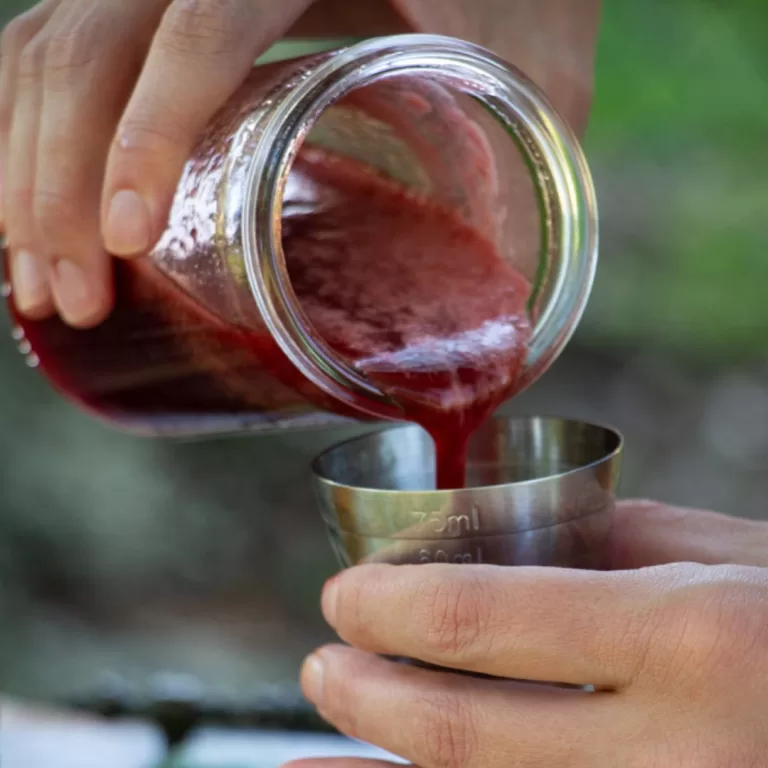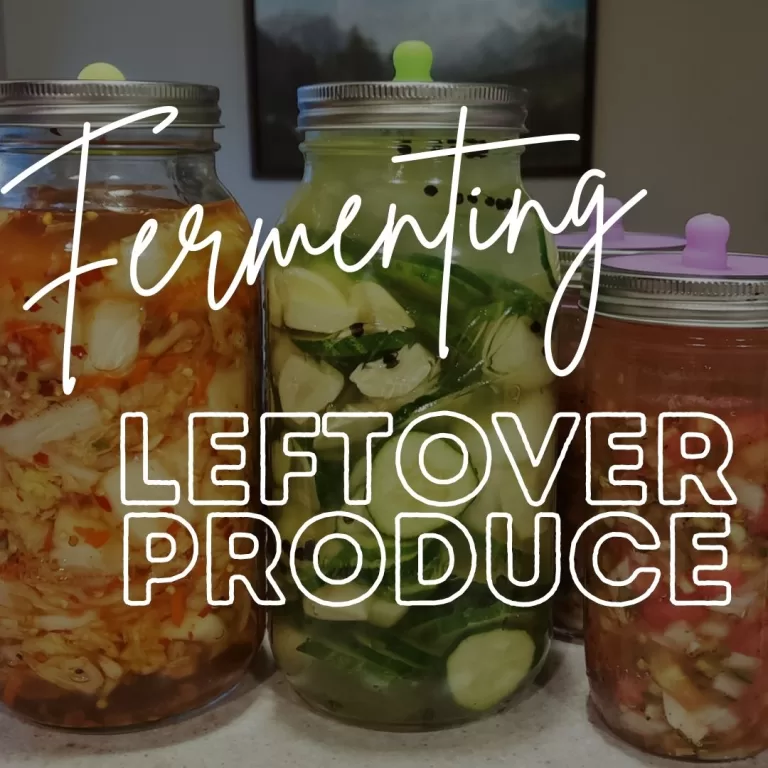Easy Immune-Boosting Herbal Mushroom Broth Recipe
As we cozy up indoors and savor the warmth of comfort foods in these colder months, there’s one ingredient that can elevate your culinary creations and nourish your body: medicinal mushrooms.
These fungi have long been celebrated for their remarkable flavors and their potential to support immune function, and a mushroom broth is one of my favorite ways to add them to your diet!
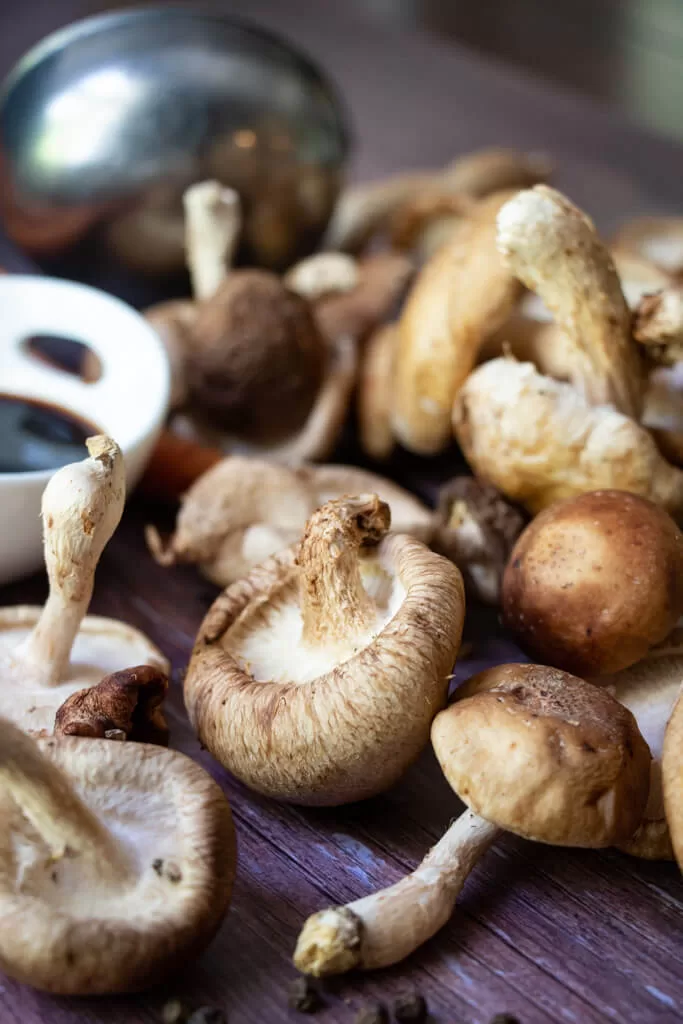
As the leaves turn and the temperatures drop, incorporating these earthy delights into your recipes can be a delightful and simple way to embrace the season. I am excited to use this fun plant in this recipe. It might just become one of my new favorite herbs for enhancing both your dishes and your well-being.
If you are interested in more ways to relish the season, check out Botanical Anthology, a publication of the Plant Wonder Collective (PWC). This post is a part of a PWC collaboration all about mushrooms, so be sure to head to Instagram to check out all the different ways you can use mushrooms this season!
Do I have to be a forager or mushroom expert to make mushroom broth?
Nope! You do not need to be an expert!
I am actually fairly new to the world of “medicinal mushrooms.” Sure, I like to eat sauteed mushrooms and have them as a common ingredient in my cooking quite frequently, but I never thought much about how medicinal they can be!
Whether you are an experienced forager, or just looking to expand your kitchen horizons, this recipe is totally attainable! I used only mushrooms found at a regular grocery store in this recipe.
However, you can certainly forage your own (if you are cooler than me). Always exercise caution when foraging wild mushrooms and consult an expert if you’re unsure about the edibility of a particular species.
You can also order dried mushrooms and mushroom powder online at Starwest Botanicals or Mountain Rose Herbs.
Immune-Boosting Herbal Mushroom Broth Recipe
As an Amazon Associate, I earn from qualifying purchases. Please visit my privacy + disclosure page for more details.
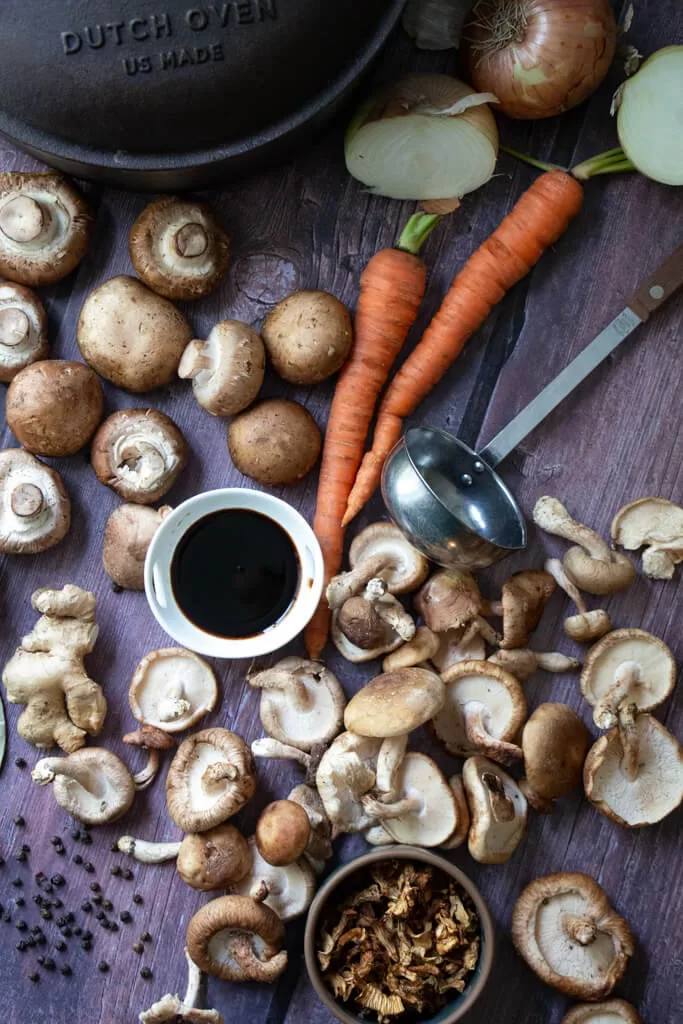
Ingredients
- 2 yellow onions, chopped
- 2 tbsp olive oil
- 1 lb fresh shiitake mushrooms, sliced
- 1 lb fresh baby Bella mushrooms, sliced
- 8 oz dried chantarelle mushrooms
- 2 carrots, chopped
- 3 bay leaves
- 1 tbsp whole black peppercorns
- 1 garlic bulb, halved
- 1-inch piece of ginger, sliced
- 2 tbsp soy sauce (optional)
- Salt to taste
- 10 cups water
Keep reading below for mushroom substitutes. I recommend using at least one dried variety, as it will add the most punch of flavor!

Garlic cloves are also important in adding an immune boost to this recipe! Don’t be shy. If you are a garlic lover like me, add in more… for good measure.
Tools
- Large Pot or Dutch Oven (I always get asked about my Dutch oven. It is from Smithey and I absolutely love it. This is an affiliate link, but my Dutch oven was a Mother’s Day gift).
- Cutting Board
- Sharp Knife
- Fine-Mesh Strainer or Cheesecloth
- Measuring Spoons and Cups
- Stirring Utensil
- Soup Ladle
- Storage Containers
Instructions
1. Sauté the Onions: In a large soup pot, heat the olive oil over medium heat. Add the chopped onions and sauté until they become translucent, about 5 minutes.

2. Add Mushrooms: Add all three types of mushrooms (shiitake, baby Bella, and dried chantarelles) to the pot. Sauté them with the onions for about 5-7 more minutes until they start to release their moisture and turn brown.

3. Add Carrots and Aromatics: Stir in the chopped carrots, bay leaves, whole black peppercorns, garlic bulb (halved), and ginger slices. Continue to cook for another 2 minutes to infuse the flavors.

4. Deglaze with Soy Sauce: Pour in the soy sauce and stir to coat the mushrooms and vegetables evenly. This will add a savory depth of flavor to your broth.

5. Add Water and Simmer: Pour in the 10 cups of water and bring the mixture to a boil. Once boiling, reduce the heat to low, cover the pot, and let it simmer for about 1 hour. This will allow the flavors to meld and create a rich broth.
Please Note: My broth is pretty cloudy. To achieve a clearer broth, do not stir during the simmer period, and let simmer as low as possible. As a toddler mom (and not a chef), I truly cannot be bothered to worry about a “clear” broth. Cloudy is A-OK with me!

6. Strain and Season: After simmering, strain the broth through a fine-mesh strainer or cheesecloth into another pot or bowl. As an added bonus, you can eat the cooked mushrooms! Discard/compost the other solids.
Season the broth with salt to taste. Start with a pinch and add more if needed.
I strain this in the sink because I am messy. But, I totally almost forgot to put a bowl under the strainer! Make sure you have a bowl under the strainer! Ope!
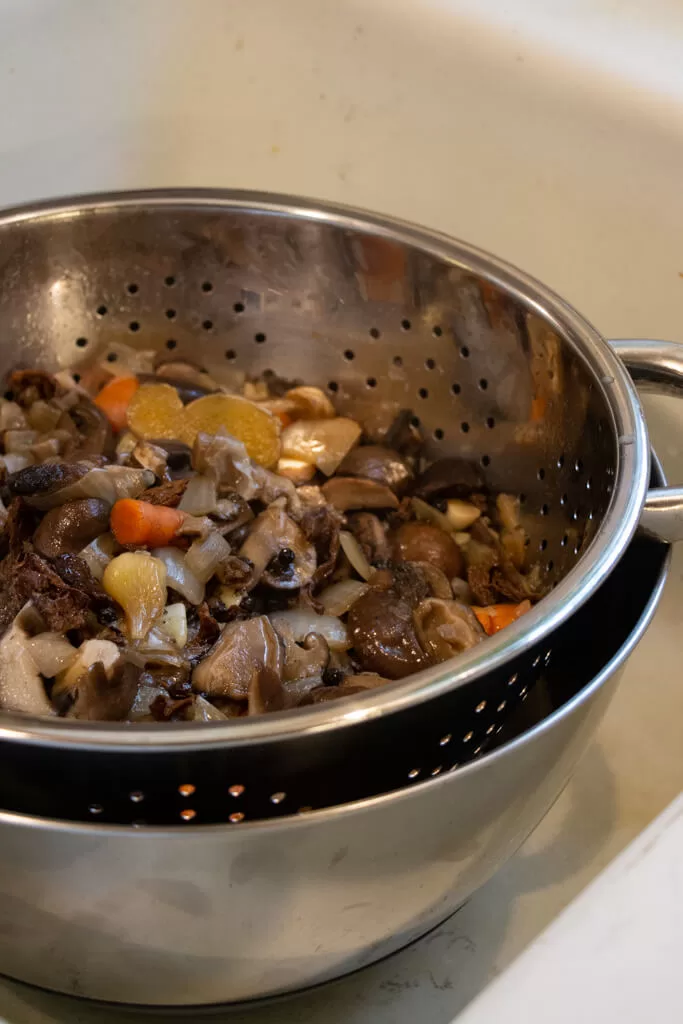
7. Serve: Your homemade mushroom broth is ready to use in soups, risottos, or any recipe that calls for broth. Enjoy the rich, umami flavor!

Mushroom Broth Storage
Store any leftover broth in an airtight container in the refrigerator for up to a week, or freeze it for longer storage (about 6 months).
My favorite way to freeze all broths is in Soup Freezing Cubes. You can freeze 1-2 cups at a time and have an immune-boosting meal ready to go at any time during the winter months.

Mushroom Health Benefits
Mushrooms, when used in broth, offer several herbal and health benefits due to their unique nutritional profile and natural compounds. Here are some of the herbal benefits of using mushrooms in a broth:
1. Immune Support: Many mushrooms, such as shiitake and maitake, contain compounds like beta-glucans that have been shown to enhance the immune system. Including these mushrooms in your broth may provide immune-boosting properties.
2. Antioxidants: Mushrooms are rich in antioxidants like ergothioneine and glutathione, which can help protect your cells from oxidative stress and support overall health.
3. Anti-Inflammatory: Certain mushrooms, like reishi and turkey tail, contain anti-inflammatory properties that may help reduce inflammation in the body. Consuming a broth with these mushrooms could potentially have anti-inflammatory effects.
4. Adaptogenic Properties: Some mushrooms (reishi and cordyceps), are considered adaptogens, which means they may help the body adapt to stress and maintain balance. Including these mushrooms in your broth might contribute to stress resilience.
5. Nutrient-Rich: Mushrooms are a good source of vitamins and minerals, including B vitamins (like niacin and riboflavin), potassium, and copper. These nutrients are essential for various bodily functions.
6. Digestive Health: Mushrooms contain dietary fiber and prebiotics, which can promote a healthy gut microbiome and aid in digestion. A mushroom-infused broth may support digestive well-being.
It’s important to note that the specific herbal benefits can vary depending on the type of mushrooms used in your broth. Different mushroom varieties have distinct health-promoting compounds.
By incorporating a variety of mushrooms into your broth, you can potentially maximize the herbal benefits and create a more well-rounded flavor profile.
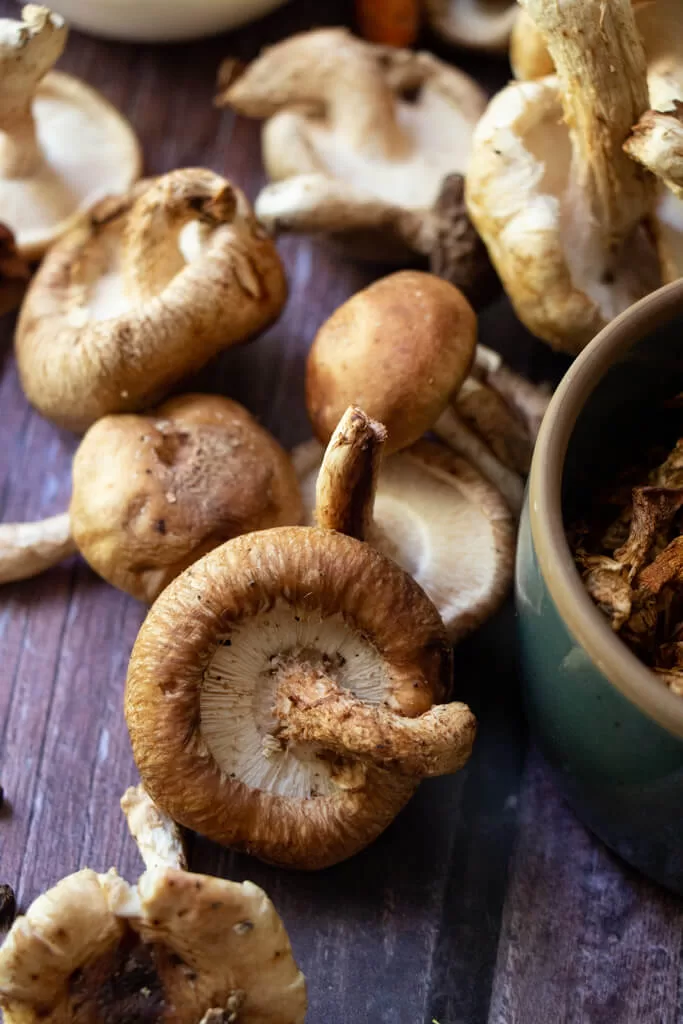
Other Mushroom Options to Add or Substitute in Your Broth
There are many other edible mushrooms you can add to your broth or use as substitutes based on your flavor preferences and availability. Here are some options:
- Reishi Mushrooms: Add these for a robust and earthy flavor boost!
- Porcini Mushrooms: These have a strong, earthy flavor and are often used in Italian cuisine. They can add depth and richness to your broth.
- Maitake Mushrooms: Also known as hen-of-the-woods, they have a robust, nutty flavor.
- Oyster Mushrooms: These have a mild, delicate flavor and a velvety texture. They can complement the broth without overpowering it.
- Enoki Mushrooms: These slender mushrooms have a mild, slightly fruity flavor and a crunchy texture.
- Lion’s Mane Mushrooms: Known for their seafood-like flavor and texture, these can add a unique twist to your broth, especially if you enjoy seafood flavors.
- Morel Mushrooms: These have a strong, earthy flavor and a distinctive appearance.
- Shimeji Mushrooms: These have a slightly nutty flavor and can be used in combination with other mushrooms to add complexity.
- Chaga Mushrooms: Chaga have a woody flavor, almost vanilla.
I would not use regular white button mushrooms found at most grocery stores, as they will not add much flavor to your broth. Instead, opt for the cremini mushrooms or portobello mushrooms for the bulk of the broth.
Remember that the choice of mushrooms can significantly influence the flavor of your broth, so feel free to experiment with different combinations to achieve the taste you desire. If you’re looking for a milder or more intense mushroom flavor, adjust the types and quantities accordingly.
Ways to Use Mushroom Broth
Mushroom broth is a versatile and flavorful liquid that can be used in a variety of dishes to enhance their taste. It can also be used to substitute chicken stock or beef broth in many recipes. Here are some common uses for mushroom broth:
- Soup Base
- Risotto
- Gravy
- Stir-Fries
- Ramen
- Sauces
- Quinoa and Rice
- Marinades
- Braising

Drink It: On its own, mushroom broth can be a comforting and nutritious drink, especially if you season it with a pinch of salt and some herbs. This is a super healthy alternative to hot chocolate if you want a warm and cozy bev to sip on.
Freeze it: Freeze mushroom broth in ice cube trays or small containers for later use. You can then add these cubes to sauces, stews, or other dishes as needed.
Mushroom Broth is the Best Immune Boosting Comfort Food to Have on hand this Season!
Remember that mushroom broth’s rich, umami flavor can be a great addition to a wide range of recipes. Feel free to get creative and use it wherever you want to enhance the taste with a mushroomy twist.
It’s clear that these earthy wonders are not just culinary delights but also allies in bolstering our immune function.
Whether you’re crafting a soul-warming soup recipe with a rich mushroom broth or simply sipping on an immunity-boosting elixir during the colder months, these fungi offer a great way to fortify your defenses, especially during the flu season. They not only elevate your dishes to new heights but also offer a delicious path to wellness. Here’s to savoring the season and nurturing our well-being, one flavorful bowl of immunity broth at a time!
Try my cold and flu tea, one of my favorite ways to combat colds during the winter season!
Pin it for Later!


About the Author:
I’m Brittany, totally modern and mainstream turned crunchy mama!
Read more here about how I went from a totally incompetent cook and hyper-consumer to striving to live a more meaningful life from scratch.
I can’t wait to share my modern homesteading journey with you and I hope I inspire you to join along!



